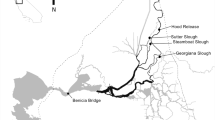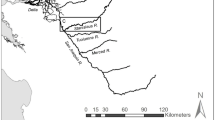Abstract
As juvenile salmonids migrate from natal streams to the ocean they can encounter junctions leading to migration routes that differ in quality and survival probability, including: side channels, agricultural diversions, floodplains, cooling intakes and turbines. Although juvenile salmon are known to use all these routes, it is often difficult to estimate what proportion of migrants may use each. Managers would benefit from knowledge of how hydrologic manipulation (e.g., dam releases, water diversions) can reduce exposure to unfavorable routes and keep more fish in higher survival routes. We assembled 41 estimates of juvenile salmon routing at six junctions in the Sacramento-San Joaquin Delta to test the ability of three hydrologic metrics to predict fish routing at distributary channels. The proportion of flow entering the distributary was selected as the best predictor and explained 70 % of observed variation in fish routing. This linear model was then used to predict routing at nine junctions under various combinations of inflow and exports. Our results suggest that more fish enter distributaries at junctions with strong riverine influence, whereas at tidally dominated junctions entrainment was lower. River inflow had the largest effect on entrainment at the two riverine-dominated junctions, although confidence intervals overlapped over the range of flows. Exports had a smaller than expected effect, but had the greatest effect at junctions directly connected to the channels with water diversions. These results suggest that flow proportion is an effective metric to predict fish routing. However, results also suggest it may be difficult to appreciably alter fish routing by manipulating river inflows or water diversions.







Similar content being viewed by others
References
Baker PF, Morhardt JE (2001) Survival of Chinook salmon smolts in the Sacramento-San Joaquin Delta and Pacific Ocean. In: Brown RL (ed) Contributions to the biology of Central Valley Salmonids. Fish Bulletin 179, pp 163–182
Bellmore JR, Baxter CV, Martens K, Connolly PJ (2013) The floodplain food web mosaic: a study of its importance to salmon and steelhead with implications for their recovery. Ecol Appl 23:189–207
Brandes PL, McLain JS (2001) Juvenile Chinook salmon abundance, distribution, and survival in the Sacramento-San Joaquin Estuary. In: Brown, R.L ed. Contributions to the Biology of Central Valley Salmonids. Fish Bulletin 179, pp 39-99
Buchanan RA, Skalski JR, Brandes PL, Fuller A (2013) Route use and survival of juvenile Chinook salmon through the San Joaquin River Delta. N Am J Fish Manag 33:216–229
Burnham KP, Anderson DR (2002) Model selection and multimodel inference: a practical information-theoretical approach (2nd edition). Springer, New York
Carlson AJ, Rahel FJ (2007) A basinwide perspective on entrainment of fish in irrigation canals. T Am Fish Soc 136:1335–1343
Holbrook CM, Perry RW, Adams NS (2009) Distribution and joint fish-tag survival of juvenile Chinook salmon migrating through the Sacramento-San Joaquin River Delta, California, 2008. U.S. Geological Survey Open-File Report 2009-1204. 30 pp
Jeffres CA, Opperman JJ, Moyle PB (2008) Ephemeral floodplain habitats provide best growth conditions for juvenile Chinook salmon in a California river. Environ Biol Fish 83:449–458
Kemp PS, Gessel MH, Williams JG (2005) Fine-scale behavioral responses of Pacific salmonid smolts as they encounter divergence and acceleration of flow. T Am Fish Soc 134:390–398
Kimmerer WJ (2008) Losses of Sacramento River Chinook salmon and Delta smelt to entrainment in water diversions in the Sacramento-San Joaquin Delta. San Francisco Estuary and Watershed Science 6(2). http://www.escholarship.org/uc/item/7v92h6fs/. Accessed August 2010
Kimmerer W, Nobriga M (2008) Investigating particle transport and fate in the Sacramento-San Joaquin Delta using a particle tracking model. San Francisco Estuary and Watershed Science 6(1). https://escholarship.org/uc/item/547917gn. Accessed January 2011
Lindley ST, Grimes CB, Mohr MS, Perterson W, Stein J, Anderson JT, Botsford LW et al. (2009) What caused the Sacramento River fall Chinook stock collapse? Report to the Pacific Fishery Management Council. http://www.pcouncil.org/wp-content/uploads/H2b_WGR_0409.pdf. Accessed Feb 2013
Michel CJ, Ammann AA, Chapman ED, Sandstrom PT, Fish HE, Thomas MJ, Singer GP, Lindley ST, Klimley AP, MacFarlane RB (2013) The effects of environmental factors on the migratory movement patterns of Sacramento River yearling late-fall run Chinook salmon (Oncorhynchus tshawytscha). Environ Biol Fish 96:257–271
National Marine Fisheries Service (NMFS) (2009) NMFS Final 2009 biological opinion on the long-term Central Valley Project and State Water Project operation, criteria, and plan. June 4, 2009. http://swr.nmfs.noaa.gov/sac/myweb8/BiOpFiles/2009/Draft_OCAP_Opinion.pdf. Accessed March 2011
National Research Council (NRC) (2012) Sustainable water and environmental management in the California Bay-Delta. Washington, DC: The National Academies Press, 2012a. http://dels.nas.edu/Report/Sustainable-Water-Environment/13394. Accessed January 2014
Newman KB, Brandes PL (2010) Hierarchical modeling of juvenile Chinook salmon survival as a function of Sacramento–San Joaquin Delta water exports. N Am J Fish Manag 30:157–169
Nichols FH, Cloern JE, Luoma SN, Peterson DH (1986) The modification of an estuary. Science 231:567–573
Perry RW (2010) Survival and migration dynamics of juvenile Chinook salmon in the Sacramento–San Joaquin River Delta. Doctoral dissertation. University of Washington
Perry RW, Brandes PL, Sandstrom PT, Ammann A, MacFarlane B, Klimley AP, Skalski JR (2010) Estimating survival and migration route probabilities of juvenile Chinook salmon in the Sacramento–San Joaquin River Delta. N Am J Fish Manag 30:142–152
Perry RW, Brandes PL, Burau JR, Klimley AP, MacFarlane B, Michel C, Skalski JR (2013) Sensitivity of survival to migration routes used by juvenile Chinook salmon to negotiate the Sacramento-San Joaquin River Delta. Environ Biol Fish 96:381–392
Post JR, van Poorten BT, Rhodes T, Askey P, Paul A (2006) Fish entrainment into irrigation canals: an analytical approach and application to the Bow River, Alberta, Canada. N Am J Fish Manag 26:875–887
Roberts JJ, Rahel FJ (2008) Irrigation canals as sink habitat for trout and other fishes in a Wyoming drainage. T Am Fish Soc 137:951–961
San Joaquin River Group Authority (SJRG) (2011) 2010 Annual technical report on implementation and monitoring of the San Joaquin River Agreement and the Vernalis Adaptive Management Plan (VAMP). http://www.sjrg.org/technicalreport/2010/2010_SJRGA_Annual_Technical_Report.pdf. Accessed Feb 2012
San Joaquin River Group Authority (SJRG) (2013) 2011 annual technical report on implementation and monitoring of the San Joaquin River Agreement and the Vernalis Adaptive Management Plan (VAMP). http://www.sjrg.org/technicalreport/2011/2011_SJRGA_AnnualTechnicalReport.pdf. Accessed June 2013
Sommer T, Nobriga ML, Harrell WC, Batham W, Kimmerer WJ (2001) Floodplain rearing of juvenile Chinook salmon: evidence of enhanced growth and survival. Can J Fish Aquat Sci 58:325–333
Sommer T, Armor C, Baxter R, Breuer R, Brown L, Chotkowski M, Culberson S, Feyrer F, Gingras M, Herbold B, Kimmerer W, Mueller-Solger A, Nobriga M, Souza K (2007) The collapse of pelagic fishes in the upper San Francisco Estuary. Fisheries 32:270–277
Steel AE, Sandstrom PT, Brandes PL, Klimley AP (2013) Migration route selection of juvenile Chinook salmon at the Delta Cross Channel, and the role of water velocity and individual movement patterns. Environ Biol Fish 96:215–224
Acknowledgments
This paper was inspired and made possible by the contributions of many people. Comments and suggestions for the emerging analysis were provided by Lenny Grimaldo, Barbara Byrne, Matt Nobriga, Pete Smith, Ted Sommer, Gardner Jones, Kevin Clark, Kevin Reece, James Newcomb, Rachel Johnson, Tara Smith and Steve Cramer. Constructive comments on early drafts of the manuscript were provided by Tara Smith, Kijin Nam, Rick Sitts, and Ted Sommer. Funding for development of this manuscript was provided by the California Department of Water Resources. We are also grateful to Aaron Miller and Mark Teply for providing their expertise with FORTRAN programming, and lastly, to Aaron Miller for sharing the DSM2 hydro data.
Author information
Authors and Affiliations
Corresponding author
Rights and permissions
About this article
Cite this article
Cavallo, B., Gaskill, P., Melgo, J. et al. Predicting juvenile Chinook Salmon routing in riverine and tidal channels of a freshwater estuary. Environ Biol Fish 98, 1571–1582 (2015). https://doi.org/10.1007/s10641-015-0383-7
Received:
Accepted:
Published:
Issue Date:
DOI: https://doi.org/10.1007/s10641-015-0383-7




